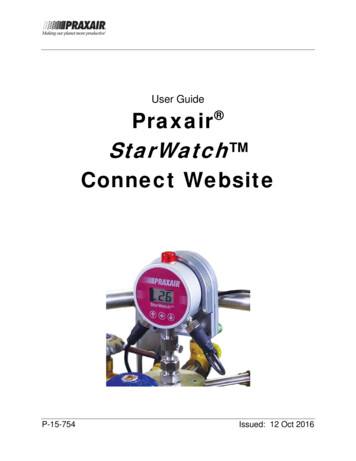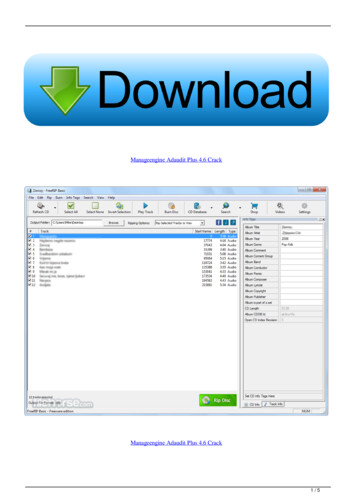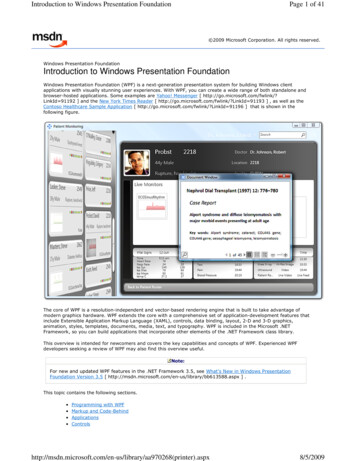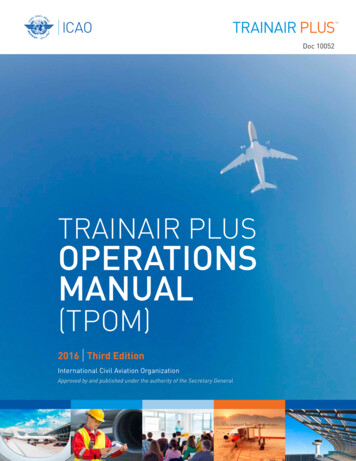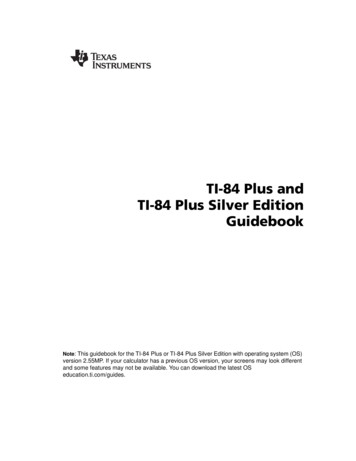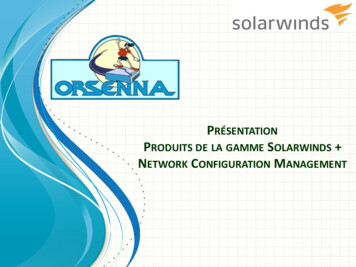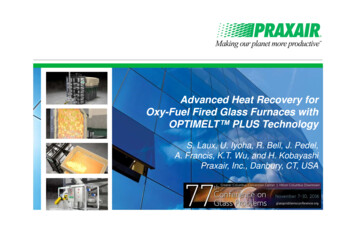
Transcription
Advanced Heat Recovery forOxy-Fuel Fired Glass Furnaces withOPTIMELT PLUS TechnologyS. Laux, U. Iyoha, R. Bell, J. Pedel,A. Francis, K.T. Wu, and H. KobayashiPraxair, Inc., Danbury, CT, USA
OPTIMELT Thermo-Chemical RegeneratorReforming of Natural Gas in regenerators recovers significant heat inthe flue gas of oxy-fuel furnaces– Regenerative system takes advantage of high operating temperatures– High efficiency non-catalytic reforming process– Recycled flue gas with CO2 and water vapor is used for endothermic CH4reforming to CO and Hydrogen (syngas)Hot syngas is burned with oxygen in the furnaceRegenerators roughly 1/3 the size of air-fired regeneratorsOPTIMELT advantages– Reduced energy consumption ( 20% vs oxy-fuel)– Reduced CO2 emissions– Reduced air pollutants to the level of oxy-fuel performance(NOx, SOx, CO, etc.)Extensive Development program started 2011– Demonstration at Pavisa and commercialization of OPTIMELT TCR– Introduction of combination with oxygen preheating: OPTIMELT Plus2
OPTIMELT System at PavisaNewExistingOxy-Fuel Flue GasTCR Flue GasRegenLeft50tpdvarious colorsRFG Skid 20%Natural GasOxygenRegenRightTCRSkidOxyfuelSkidSide-fired oxy-fuelfurnace converted toend-port TCROxy-fuel system onstand-by as backup3
Status Pavisa Furnace 13Operation– System in automatic and continuous operation since September 2014 System turned over to Pavisa, formal acceptance by Pavisa Reliable operation (99.7% availability May/June excluding power failures)––––Glass pull rate and quality continue to be within Pavisa requirementsEmissions in the range of emissions for Low NOx glass oxy-fuel burnersEnergy reduction 15 to 18% - in line with expectations for 50tpd furnaceNo fundamental TCR technology issues identifiedWide Flame Burner Gen III for OPTIMELT tested in Furnace 13– New cooling concept to allow idle burners for future commercial projects– Tested successfully two months, temperatures are within material limitsEnd-firing of Oxy-fuel Combustion System as an alternative to the sidefired oxy-fuel burners installed in MayRefractory testing in regenerators continuesPavisa continues to support ongoing OPTIMELT development4
Regenerator and Checker PerformanceSummer Inspection: Checker in verygood condition after 22 months– Passages free of deposits– No signs of corrosion– Light deposits at bottom, easy to cleanPort neck and regenerator top refractorywas not the right choice for application– Nepheline spalling of material in hottest zone– Better material identified, replacement 2016Lower regenerator walls and rider archesin very good conditionDampers, ducts and fan deposits– Cleaning no problem, no operational impactVery encouraging results, valuable information for scale-up5
Refractory Test Program ContinuesRefractory selection program tests are ongoingTest Rounds:––––1 completed: 8 months2 completed: 1 month (quick screening test for exclusion of refractories)3 currently ongoing for 9 months4 in preparationRound 1 and 2 results were used in the selection of the refractory fornext commercial project– Observed corrosion patterns typical for glass furnace conditions– SiO2 reduction by H2 /CO/C in syngas was not observed– Selection not a straightforward scientific process, actual testing is important Very high alumina and Magnesia samples promising Fused-cast AZS refractories superior to bonded material– Surprising differences in same classes or material due to details in composition andmanufacturing matterTechnology Development guided by Pavisa Refractory Exposure Tests6
OPTIMELT Status Leerdam 1Installation on tableware furnace– Praxair VPSA oxygen supply with liquid oxygen backup– Libbey Motivation: fuel and oxygen savings, emissions, sustainabilityPartial Project funding by EU (LIFE Grant LIFE15 CCM-NL-000121)Engineering and DesignOxy-Fuel Port Neckphase nearly completeOPTIMELT– Sorg: Furnace, Regeneratorsand Oxy-fuel system– Praxair: OPTIMELT systemand JL Oxy-fuel BurnersPort NecksOxy-fuel BurnersProcurement underway– EU fabrication requirementConstruction and startup 2017Downcomer forFlue GasRight/Left RegeneratorLIFE15 CCM/NL/000121OPTIMELT Flue Gas Skid7
OPTIMELT PLUS Technology
OPTIMELT Plus TechnologyHigh efficiency non-catalytic reforming process (OPTIMELT) coupled withregenerative oxygen preheating (Plus)Recycled flue gas with CO2 and water vapor is used for CH4 reformingRegenerative system allows high operating temperatures/reforming rateREGENERATORSOxy-fuel Glass Furnace 1500 C 2700 F1-TCRHot Syngas 1200 C 2200 F1-O22-TCRHot OxygenUS Patents 6,113,874 and 5,921,771Flue GasCO2 2H2O2-O2Flue Gas Recycle ( 20%)NG (CH4)Oxygen (O2) 1200 C 2200 FTCR Endothermic reforming reactionsCH4 H2OCH4 CO2CO 3H22CO 2H22060 kcal/Nm3 CH4 (215 Btu/scf-CH4)2630 kcal/Nm3 CH4 (275 Btu/scf-CH4)9
OPTIMELT Plus BenefitOPTIMELT Plus improves the heat recovery by another 5% incomparison to OPTIMELT– Example heat and mass balance comparison of the two heat recoverytechnologies below– 240 t/d container furnace with 1 MW electric boost and 30% cullet 03.22.95MMBtu/ton3.83.02.8Fuel Savings%base21.326.6Flue Gas Temperature C1500650400 F27001200750Fuel Input10
System LayoutOxygen preheating to 1200 C with secondset of regeneratorsTotal checker volume less than OPTIMELTConcept engineering and costing completefor 240tpd furnaceOxygenSyngasFront: TCR Syngas RegeneratorsBack: Oxygen Regenerators11
CFD Model OPTIMELT Plus 240tpdPlan View (cut through upper port)Side View (cut through left port)1000 C1400 C1800 CFlame is formed at the interface of hot syngas with hot oxygen––––Technology to shape flame similar to OPTIMELT TCRNo overheating of ports, walls or crownFlame can be positioned in furnace to achieve desired heat transferCombustion technology prevents large area of unburned fuel in the furnace12
Options for Heat RecoveryOPTIMELT TCR flue gas leaves regenerators at 650 C (1200 F)Technology can be combined with many heat recovery options– Regenerative oxygen preheat: OPTIMELT Plus– Integrated batch/cullet or cullet preheating No air dilution required due to lower temperature of flue gas Requirement to remove the organic fume/odor from the flue gas after a culletpreheater– Additional heat recovery options from flue gas Boiler and turbine (ORC) Steam boiler to generate reforming steam for TCR Recuperative oxygen preheat to 500 CRegenerative oxygen preheating– Stand-alone preheater to 1200 C– Combination with batch/cullet preheating13
Examples of Heat Recovery Options14
Fuel Savings of Heat Recovery OptionsResults of heat and mass balances (300tpd container furnace at 50% cullet)Case1234567Heat Recovery SystemOxy-fuelOPTIMELT Thermochemical Regenerator (TCR)OPTIMELT Plus (TCR with O2 Regenerator)OPTIMELT TCR with Cullet PHOxygen Regenerator (100% O2 purity, PH to 1200 C)Oxygen Regenerator with Cullet PHOxygen Regenerator with Batch/Cullet PHFuel Savings (%)baseline202529112228Efficient heat recovery with OPTIMELT lowers level of available heatFurther heat recovery feasible (some options with diminishing returns)Integration issues and environmental impact must be consideredAdditional CAPEX must be balanced against incremental heat recovery15
SummaryPraxair’s OPTIMELT Thermochemical Regenerator (TCR)– High reduction of fuel consumption(container furnace: 20% vs oxy-fuel, 30% vs. air-regenerative)– Reduces CO2 emissions– Reduces air pollutants to the level of oxy-fuel performance(NOx, SOx, CO, etc.)Pavisa System in automatic and continuous operationTwo commercial size projects in engineering phase– Libbey L1: end-fired tableware furnace with side-fired oxy-burners– Customer 2: 240 tpd end-fired container furnace (flint glass) with endfired oxy-burnersOPTIMELT Plus – a novel technology that maximizes heatrecovery without large equipment addition16
Thank You for your Attention!Please stop by at our booth at the Hilton!Stefan Laux@Praxair.com17
Praxair's OPTIMELT Thermochemical Regenerator (TCR) - High reduction of fuel consumption (container furnace: 20% vs oxy-fuel, 30% vs. air-regenerative) - Reduces CO 2 emissions - Reduces air pollutants to the level of oxy-fuel performance (NOx, SOx, CO, etc.) Pavisa System in automatic and continuous operation
